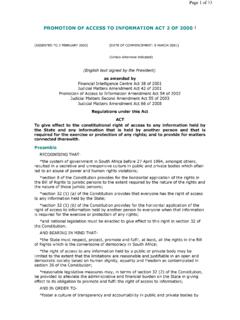Transcription of Manifestly unreasonable requests - regulation 12(4)(b)
1 ICO lo Manifestly unreasonable requests - regulation 12(4)(b). Environmental Information regulations Contents 2. Overview .. 2. What the EIR say .. 3. General principles of the exception .. 3. Manifestly unreasonable on the grounds that the request is vexatious .. 4. Manifestly unreasonable on the grounds of costs or diversion of resources .. 5. General approach .. 5. Differences and similarities to 7. Advice and assistance .. 9. The public interest 10. Public interest in maintaining the exception .. 10. Public interest in disclosure .. 10. requests for mixed (both FOI and EIR) information .. 11. Neither confirm nor deny .. 12. What the ICO will expect from an authority .. 13. Other considerations .. 13. More information .. 14. Manifestly unreasonable requests ( regulation 12(4)(b)). 20130315. Version: 1. Introduction 1. The Environmental Information regulations 2004 (EIR) give rights of public access to information held by public authorities. 2. An overview of the main provisions of the EIR can be found in The Guide to the Environmental Information regulations .
2 3. This is part of a series of guidance, which goes into more detail than the Guide, to help public authorities to fully understand their obligations and promote good practice. 4. This guidance explains to public authorities how to deal with requests for information which are Manifestly unreasonable . Overview The EIR allow public authorities to refuse a request for information which is Manifestly unreasonable . The inclusion of the word Manifestly means that there must be an obvious or clear quality to the unreasonableness. This exception can be used: o when the request is vexatious; or o when the cost of compliance with the request would be too great. In practice there is no material difference between a request that is vexatious under section 14(1) of FOIA and a request that is Manifestly unreasonable on vexatious grounds under the EIR. There may, however, be material differences between a request that can be refused under section 12 of FOIA (the costs limit). and a request that can be refused as Manifestly unreasonable under the EIR on the grounds of costs or diversion of resources.
3 This exception is subject to a public interest test. In practice however, many of the issues relevant to the public interest test will have already been considered when deciding if the exception is engaged. 2. Manifestly unreasonable requests ( regulation 12(4)(b)). 20130315. Version: 1. What the EIR say 5. regulation 12(4)(b) states: 12(4) For the purposes of paragraph (1)(a), a public authority may refuse to disclose information to the extent that . (b) the request for information is Manifestly unreasonable General principles of the exception 6. The EIR allow public authorities to refuse a request for information that is Manifestly unreasonable . The inclusion of the word Manifestly means that there must be an obvious or clear quality to the unreasonableness. 7. The purpose of the exception is to protect public authorities from exposure to a disproportionate burden or an unjustified level of distress, disruption or irritation, in handling information requests . 8. The exception can be used: when the request is vexatious; or when the cost of compliance with the request is too great.
4 9. In theory there could be other circumstances in which a request might be Manifestly unreasonable and public authorities are free to make arguments on other grounds they consider to be relevant. However, in reality, we would expect the bullet points above to cover the vast majority of Manifestly unreasonable requests . 10. Public authorities should also note that we consider this exception to be concerned with the nature of the request and the impact of dealing with it and not any adverse effect that might arise from disclosure of the content of the information requested. If a public authority is concerned about the content of the requested information being disclosed then it should consider whether another exception applies. Guidance on the all the EIR exceptions can be found via our guidance index. 3. Manifestly unreasonable requests ( regulation 12(4)(b)). 20130315. Version: 1. 11. In practice there is no material difference between a request that is vexatious under section 14(1) of FOIA and a request that is Manifestly unreasonable on vexatious grounds under the EIR.
5 12. There may, however, be material differences between a request that can be refused under section 12 of FOIA (the appropriate costs limit) and a request that can be refused as Manifestly unreasonable under the EIR on the grounds of costs or diversion of resources. Manifestly unreasonable on the grounds that the request is vexatious 13. Detailed guidance on when a request can be considered to be vexatious under section 14(1) of FOIA can be found via our guidance index. Public authorities should use this guidance when considering whether a request for environmental information is Manifestly unreasonable on the grounds that it is vexatious. 14. Although there are some differences between the structure of the relevant provisions in FOIA and the EIR, these should make no difference in practice. Example This issue was considered in the Upper Tribunal case of Craven v The Information Commissioner and the Department of Energy and Climate Change [2012] UKUT442 (AAC). Judge Wikeley's conclusion was as follows: I do not believe that the existence of the of the explicit public interest test in the EIR and the statutory presumption of a restrictive interpretation of regulation 12(4)(b) should mean that, even at the margins, it is in some way easier to get a request accepted under the EIR than under FOIA.
6 (paragraph 22). 15. Public authorities will still need to go through the process of applying a public interest test under the EIR (which is not 4. Manifestly unreasonable requests ( regulation 12(4)(b)). 20130315. Version: 1. required under FOIA). For more guidance on how this works please refer to the section below on the public interest test. 16. We would not expect a public authority that refuses a request as Manifestly unreasonable on the grounds that it is vexatious to provide the requester with advice and assistance, although it is free to do so if it wishes. Manifestly unreasonable on the grounds of costs or diversion of resources General approach 17. Under the EIR, unlike under FOIA, there is no appropriate costs limit above which public authorities are not required to deal with requests for information. The main provision for dealing with burdensome requests under the EIR is regulation 7(1). 7(1) Where a request is made under regulation 5, the public authority may extend the period of 20 working days referred to in paragraph (2) to 40 working days if it reasonably believes that the complexity and volume of the information requested means that it is impracticable either to comply with the request within the earlier period or to make a decision to refuse to do so.
7 18. However, the exception at regulation 12(4)(b) of the EIR can apply if the cost or burden of dealing with a request is too great. Example This position was confirmed, again in the Upper Tribunal case of Craven v The Information Commissioner and the Department of Energy and Climate Change [2012] UKUT442. (AAC). Taking the position under the EIR first, it must be right that a public authority is entitled to refuse a single extremely burdensome request under regulation 12(4)(b) as Manifestly unreasonable , purely on the basis that the cost of compliance would be too great (assuming, of course, it is also satisfied that the public interest test favours maintaining the exception). The absence of any provision in the EIR equivalent 5. Manifestly unreasonable requests ( regulation 12(4)(b)). 20130315. Version: 1. to section 12 of FOIA makes such a conclusion inescapable.. (paragraph 25). 19. In assessing whether the cost or burden of dealing with a request is too great , public authorities will need to consider the proportionality of the burden or costs involved and decide whether they are clearly or obviously unreasonable .
8 20. This will mean taking into account all the circumstances of the case including: the nature of the request and any wider value in the requested information being made publicly available;. the importance of any underlying issue to which the request relates, and the extent to which responding to the request would illuminate that issue;. the size of the public authority and the resources available to it, including the extent to which the public authority would be distracted from delivering other services; and the context in which the request is made, which may include the burden of responding to other requests on the same subject from the same requester. 21. It should be noted that public authorities may be required to accept a greater burden in providing environmental information than other information. Example This was confirmed in a preliminary decision of the Information Tribunal in the case of Department for Business Enterprise and Regulatory reform (DBERR) vs the Information Commissioner and Platform (EA/2008/0097).
9 In this case the tribunal considered the relevance of regulation 7(1) and commented as follows (paragraph 39): We surmise from this that Parliament intended to treat environmental information differently and to require its disclosure in circumstances where information may not have to be disclosed under FOIA. This is evident also in the fact that the EIR contains an express presumption in favour of 6. Manifestly unreasonable requests ( regulation 12(4)(b)). 20130315. Version: 1. disclosure, which FOIA does not. It may be that the public policy imperative underpinning the EIR is regarded as justifying a greater deployment of resources. We note that recital 9 of the Directive calls for disclosure of environmental information to be to the widest extent possible . Whatever the reasons may be, the effect is that public authorities may be required to accept a greater burden in providing environmental information than other information.. Differences and similarities to FOIA. 22. In assessing the level of costs that might be incurred in responding to a request , we suggest that public authorities use a rate of 25 per hour for any staff time involved.
10 This is in line with the rate applicable under FOIA by virtue of The Freedom of Information and Data Protection (Appropriate Limit and Fees) regulations 2004. This does not mean that the FOIA fees regulations apply to requests that fall to be considered under the EIR. However, we take these regulations to give a clear indication of what Parliament considered to be a reasonable charge for staff time. 23. In assessing whether the cost, or the amount of staff time involved in responding to a request , is sufficient to render a request Manifestly unreasonable the FOIA fees regulations may be a useful starting point. They are not, however, determinative in any way. Example In ICO decision notice FS50121519, the public authority, DBERR, had originally refused the request under section 12 of FOIA. When the Commissioner alerted the public authority to the fact that some of the information requested was environmental information, the public authority suggested that if this were the case, the request should still be refused under regulation 12(4)(b) as Manifestly unreasonable .
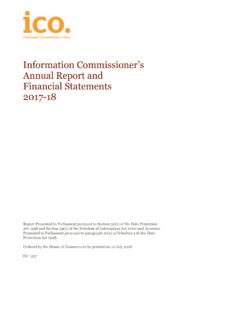
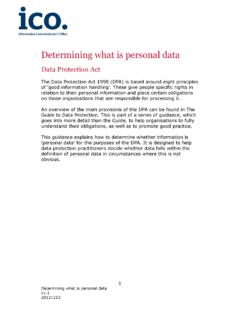





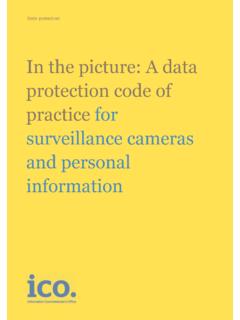


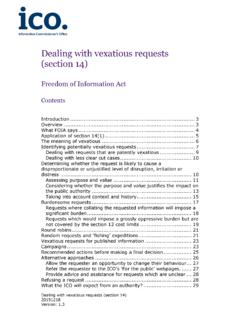

![Promotion of Access to Information Act [No. 2 of 2000]](/cache/preview/d/c/f/2/6/3/0/e/thumb-dcf2630e7ca4559eb92d749199eae4f7.jpg)


